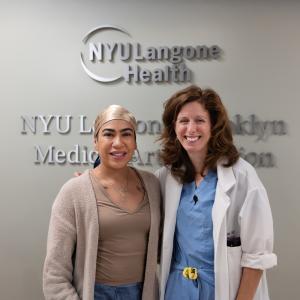NYU Langone Hospital—Brooklyn Provides High-Quality Healthcare—with Measurable Outcomes—to the Borough’s Underserved Populations
NYU Langone Hospital—Brooklyn is making tremendous strides to provide high-quality healthcare—with measurable outcomes—to the borough’s underserved populations.
Working with primary care providers and community organizations, the hospital is midway through a five-year, federally funded demonstration project called Delivery System Reform Incentive Payment, or DSRIP. The initiative is sponsored by the U.S. Centers for Medicare and Medicaid and administered by the New York State Department of Health. It began in April 2015 and is set to conclude in 2020.
The hospital participates as NYU Langone Brooklyn Performing Provider System, or PPS, which includes the Family Health Centers at NYU Langone and more than 200 primary care and mental health providers, social service organizations, nursing homes, pharmacies, and other community-based organizations (CBOs). “We work with community groups who know the patients and are trusted by them,” says Alessandra Taverna-Trani, director of the PPS. “CBOs are valuable partners and collaborators in devising and deploying effective strategies to address social determinants of health, and cultural, linguistic, and literacy barriers to healthcare access.”
The PPS has 9 projects designed to address the specific needs of approximately 114,000 patients on Medicaid, many from southwest Brooklyn. They are broken into three main categories:
- system transformation: developing an integrated care-delivery system including three emergency department-related initiatives
- clinical improvement: focusing on improving behavioral health, and asthma and diabetes management
- population health: working on HIV education and prevention, and reduction of tobacco use
“The DSRIP program has an overarching goal of reducing avoidable admission to the hospital and the emergency department by 25 percent,” says Larry K. McReynolds, executive director of Family Health Centers at NYU Langone and executive sponsor of the PPS. Participants and partners are rewarded for meeting outcome benchmarks.
McReynolds points to recently released second-year data to show that the PPS is making promising strides. “We’ve reduced potentially preventable emergency department readmissions by more than 4 percent above statewide projections and we achieved a 20 percent reduction in behavioral health-related admissions,” he says proudly.
Changing Medicine in Meaningful Ways
To foster greater access to services, Family Health Centers at NYU Langone has made operational changes, including expanded hours; same-day appointments; equipment upgrades; expediting referrals to dental and eye care services; and providing more patient education and wellness care. “Our embedded case managers look at the condition of the whole patient, not just a single illness,” says McReynolds. “Each change we have implemented is designed to lower or eliminate barriers to access and to give our patients a positive experience.”
In addition, the Patient Navigation Center (PNC), which utilizes community health workers to provide additional support to high-risk patients across the care continuum, will begin operations this year. “The PNC will ensure that our most vulnerable patients are connected with the right services at the right time and in the right place to address the range and complexity of issues that drive avoidable hospital admissions and healthcare expense,” says Taverna-Trani.
Emergency rooms often serve as a main source of healthcare for underserved populations without access to primary care. In the emergency department, patients are assessed and stabilized by a multidisciplinary team including doctors, physician assistants, and nurses. Social workers and care managers help coordinate effective care transitions to outpatient primary care for follow up. Patients requiring hospitalization can be admitted as inpatient or placed in the hospital’s 12-bed observation unit.
“In the observation unit, we specialize in the management of illnesses that typically require a short-term hospital stay, such as chest pain, cellulitis, pneumonia, stroke, chronic obstructive pulmonary disease (COPD), and asthma,” explains Christopher Caspers, MD, chief of observation medicine for NYU Langone Health. “Our best practice model of using evidence-based clinical protocols helps reduce hospital admissions and promotes reliable, high-quality clinical outcomes. We can provide effective care in less time than on a traditional ‘inpatient’ unit, benefitting both the patient and the healthcare system.”
Behavioral health also drives many emergency department visits and hospitalizations. An important change implemented through the PPS is providing physical and mental health services in the same setting, an arrangement that is working successfully at PPS partners such as the Family Health Centers at NYU Langone, the ODA Primary Health Care Network, and Ezra Medical Center.
“Patients who suffer from mental health issues are difficult to fully engage in caring for their physical health conditions,” says W. Gordon Frankle, MD, chief of psychiatry at NYU Langone Hospital—Brooklyn. “When they are assessed for mental and physical health issues simultaneously, we see improvement in compliance with treatment. And those who require a higher level of care can be referred to an appropriate PPS partner.”
“Unhealthy behavior impacts both physical and mental status of patients,” says Jon Marrelli, PsyD, who chairs the PPS’s behavioral health project. Problems like obesity, diabetes, chronic pain, and tobacco-related illness can be caused or exacerbated by unhealthy behaviors. Similarly, those with anxiety problems are more prone to unhealthy lifestyle habits such as smoking, which, in turn, makes them more prone to asthma, COPD, or cardiac problems. Depression and diabetes go hand in hand. And many who suffer from substance abuse need ongoing attention for other health issues.
“Another benefit of co-locating behavioral health services within primary care settings is that patients are spared the stigma of going to a stand-alone mental health clinic and more likely to do one-stop shopping for all their health needs,” Dr. Marrelli adds.
For clinical projects on community-based health navigation services, behavioral health, asthma, and diabetes, CBO partners—including the Caribbean Women’s Health Association, CAMBA, Arab American Family Support Center, and Chinese American Planning Council— will use ethnically and culturally appropriate training material developed in partnership with the Arthur Ashe Institute for Urban Health, the lead community-based PPS partner.
What’s Ahead
According to McReynolds, NYU Langone Health’s strength in data analytics and experience with best practice protocols has been tremendously helpful with standardizing quality care. “As we face the prospect of a value-based payment system, which shifts financial risk to hospitals, such tools will facilitate ongoing monitoring of performance in delivering high- quality patient care,” he says.
As New York State evaluates the past year’s results, and as year four progresses, Taverna-Trani adds: “We will continue to build and improve our infrastructure and information technology connectivity, enabling us to share information and communicate more effectively and efficiently with our partners so we can achieve and sustain a fully integrated healthcare delivery system after DSRIP.”
Media Inquiries
Colin DeVries
Phone: 718-630-7414
colin.devries@nyumc.org

